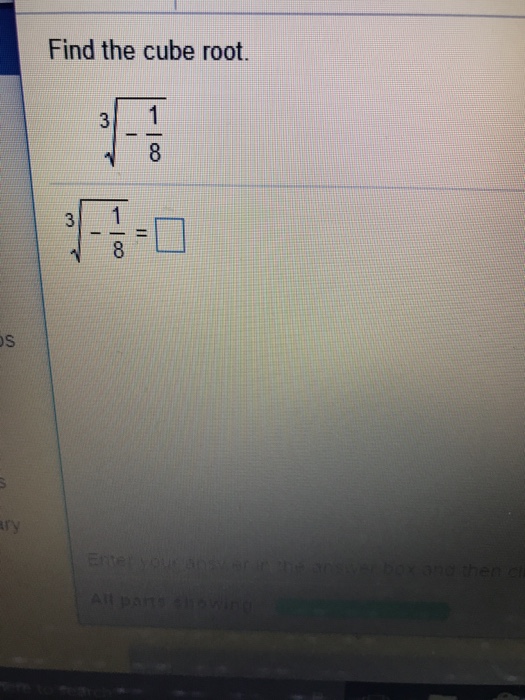Topic negative b plus or minus square root: Unlock the secrets of solving quadratic equations with the powerful quadratic formula, often expressed as "negative b plus or minus square root." This comprehensive guide will help you understand, derive, and apply this essential mathematical tool, making complex problems simpler and more approachable. Dive in and master the quadratic formula today!
Table of Content
- Quadratic Formula
- Introduction to Quadratic Equations
- Understanding the Quadratic Formula
- Derivation of the Quadratic Formula
- Components of the Quadratic Formula
- Step-by-Step Solution Using the Quadratic Formula
- Discriminant and Its Significance
- Real and Complex Roots
- Examples and Practice Problems
- Common Mistakes to Avoid
- Applications of the Quadratic Formula
- Graphical Interpretation
- Conclusion and Summary
- YOUTUBE: Xem video này để hiểu tại sao căn bậc hai của 36 chỉ là số 6 dương và không có giá trị âm.
Quadratic Formula
The quadratic formula is used to solve quadratic equations of the form \(ax^2 + bx + c = 0\). The formula is given by:
\[
x = \frac{-b \pm \sqrt{b^2 - 4ac}}{2a}
\]
Steps to Solve Using the Quadratic Formula
- Identify the coefficients \(a\), \(b\), and \(c\) in the quadratic equation \(ax^2 + bx + c = 0\).
- Calculate the discriminant, \(\Delta\), using the formula: \[ \Delta = b^2 - 4ac
- Evaluate the square root of the discriminant, \(\sqrt{\Delta}\).
- Apply the quadratic formula: \[ x = \frac{-b \pm \sqrt{\Delta}}{2a}
- Simplify the expression to find the two possible values of \(x\).
Example
Consider the quadratic equation \(2x^2 + 4x - 6 = 0\). The coefficients are \(a = 2\), \(b = 4\), and \(c = -6\).
- Calculate the discriminant: \[ \Delta = 4^2 - 4 \cdot 2 \cdot (-6) = 16 + 48 = 64
- Evaluate the square root of the discriminant: \[ \sqrt{64} = 8
- Apply the quadratic formula: \[ x = \frac{-4 \pm 8}{4} = \frac{-4 + 8}{4} \text{ or } \frac{-4 - 8}{4} \]
- Simplify to find the two solutions: \[ x = 1 \text{ or } x = -3
Conclusion
The quadratic formula is a powerful tool for solving quadratic equations. By following the steps outlined above, you can find the solutions to any quadratic equation of the form \(ax^2 + bx + c = 0\).
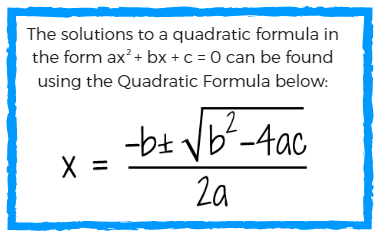
READ MORE:
Introduction to Quadratic Equations
Quadratic equations are fundamental in algebra and appear in various fields such as physics, engineering, and finance. A quadratic equation is a second-degree polynomial equation in a single variable \(x\) with the general form:
\[
ax^2 + bx + c = 0
\]
where \(a\), \(b\), and \(c\) are constants, and \(a \neq 0\). The solutions to this equation are the values of \(x\) that satisfy the equation.
To solve quadratic equations, one of the most commonly used methods is the quadratic formula, which is expressed as:
\[
x = \frac{-b \pm \sqrt{b^2 - 4ac}}{2a}
\]
The quadratic formula provides the solutions to any quadratic equation by following these steps:
- Identify the coefficients \(a\), \(b\), and \(c\) in the quadratic equation.
- Calculate the discriminant, \(\Delta\), using the formula: \[ \Delta = b^2 - 4ac \]
- Evaluate the square root of the discriminant, \(\sqrt{\Delta}\).
- Apply the quadratic formula: \[ x = \frac{-b \pm \sqrt{\Delta}}{2a} \]
- Simplify the expression to find the two possible values of \(x\).
The sign of the discriminant \(\Delta\) determines the nature of the roots:
- If \(\Delta > 0\), there are two distinct real roots.
- If \(\Delta = 0\), there is one real root (a repeated root).
- If \(\Delta < 0\), there are two complex roots.
Understanding and solving quadratic equations is crucial for tackling more complex mathematical problems. By mastering the quadratic formula and its applications, you'll be well-equipped to handle a wide range of algebraic challenges.
Understanding the Quadratic Formula
The quadratic formula is a powerful tool used to find the solutions of quadratic equations. Given a quadratic equation of the form:
\[
ax^2 + bx + c = 0
\]
The solutions for \(x\) can be found using the quadratic formula:
\[
x = \frac{-b \pm \sqrt{b^2 - 4ac}}{2a}
\]
This formula allows us to determine the roots of any quadratic equation by following these detailed steps:
- Identify the coefficients:
Determine the values of \(a\), \(b\), and \(c\) from the given quadratic equation. Ensure that \(a \neq 0\).
- \(a\) is the coefficient of \(x^2\)
- \(b\) is the coefficient of \(x\)
- \(c\) is the constant term
- Calculate the discriminant:
The discriminant, denoted as \(\Delta\), is calculated using the formula:
\[
\Delta = b^2 - 4ac
\]The value of the discriminant determines the nature of the roots.
- Evaluate the square root of the discriminant:
Calculate \(\sqrt{\Delta}\). This step is crucial as it affects the solutions of the quadratic equation.
- Apply the quadratic formula:
Substitute the values of \(b\), \(\sqrt{\Delta}\), and \(a\) into the quadratic formula:
\[
x = \frac{-b \pm \sqrt{\Delta}}{2a}
\]The \(\pm\) symbol indicates that there are generally two solutions:
- \[ x_1 = \frac{-b + \sqrt{\Delta}}{2a} \]
- \[ x_2 = \frac{-b - \sqrt{\Delta}}{2a} \]
- Interpret the results:
Based on the value of the discriminant \(\Delta\):
- If \(\Delta > 0\), the equation has two distinct real roots.
- If \(\Delta = 0\), the equation has one real root (a repeated root).
- If \(\Delta < 0\), the equation has two complex roots.
By following these steps, you can efficiently solve any quadratic equation using the quadratic formula. This method provides a systematic approach to finding the roots, ensuring accuracy and reliability in solving algebraic problems.
Derivation of the Quadratic Formula
The quadratic formula can be derived by completing the square on the general quadratic equation:
\[
ax^2 + bx + c = 0
\]
Follow these steps to derive the quadratic formula:
- Divide the equation by \(a\):
Assume \(a \neq 0\) and divide every term by \(a\) to normalize the coefficient of \(x^2\).
\[
x^2 + \frac{b}{a}x + \frac{c}{a} = 0
\] - Move the constant term to the other side:
Subtract \(\frac{c}{a}\) from both sides of the equation.
\[
x^2 + \frac{b}{a}x = -\frac{c}{a}
\] - Complete the square:
Add and subtract \(\left(\frac{b}{2a}\right)^2\) inside the equation to complete the square.
\[
x^2 + \frac{b}{a}x + \left(\frac{b}{2a}\right)^2 = -\frac{c}{a} + \left(\frac{b}{2a}\right)^2
\] - Rewrite the left side as a perfect square:
The left side of the equation now becomes a perfect square trinomial.
\[
\left(x + \frac{b}{2a}\right)^2 = -\frac{c}{a} + \frac{b^2}{4a^2}
\]Simplify the right side:
\[
\left(x + \frac{b}{2a}\right)^2 = \frac{b^2 - 4ac}{4a^2}
\] - Take the square root of both sides:
Apply the square root property to both sides of the equation.
\[
x + \frac{b}{2a} = \pm \sqrt{\frac{b^2 - 4ac}{4a^2}}
\]Simplify the right side:
\[
x + \frac{b}{2a} = \pm \frac{\sqrt{b^2 - 4ac}}{2a}
\] - Isolate \(x\):
Solve for \(x\) by subtracting \(\frac{b}{2a}\) from both sides.
\[
x = -\frac{b}{2a} \pm \frac{\sqrt{b^2 - 4ac}}{2a}
\]Combine the terms over a common denominator:
\[
x = \frac{-b \pm \sqrt{b^2 - 4ac}}{2a}
\]
Thus, the quadratic formula is derived, providing the solutions to any quadratic equation in the form \(ax^2 + bx + c = 0\). This derivation showcases the elegance and power of algebraic manipulation in solving polynomial equations.
Components of the Quadratic Formula
The quadratic formula is a concise expression that provides the solutions to any quadratic equation of the form:
\[
ax^2 + bx + c = 0
\]
The formula itself is written as:
\[
x = \frac{-b \pm \sqrt{b^2 - 4ac}}{2a}
\]
This formula contains several critical components, each playing a vital role in determining the solutions of the quadratic equation. These components are:
- Coefficient \(a\):
The coefficient of the quadratic term \(x^2\). It must be non-zero (\(a \neq 0\)), as a zero value would make the equation linear rather than quadratic.
- Coefficient \(b\):
The coefficient of the linear term \(x\). It can be positive, negative, or zero, affecting the position and shape of the parabola represented by the quadratic equation.
- Constant \(c\):
The constant term, independent of \(x\). It represents the y-intercept of the quadratic function when plotted on a graph.
- Discriminant (\(\Delta\)):
Given by the expression:
\[
\Delta = b^2 - 4ac
\]The discriminant determines the nature of the roots of the quadratic equation:
- If \(\Delta > 0\), there are two distinct real roots.
- If \(\Delta = 0\), there is one real root (a repeated root).
- If \(\Delta < 0\), there are two complex roots.
- Square Root Component (\(\sqrt{b^2 - 4ac}\)):
This part of the formula computes the square root of the discriminant. It is crucial for determining the two possible solutions, represented by the \(\pm\) symbol.
- Numerator (\(-b \pm \sqrt{b^2 - 4ac}\)):
The numerator consists of two parts: \(-b\) and \(\pm \sqrt{b^2 - 4ac}\). The \(-b\) shifts the solutions left or right on the number line, while the \(\pm \sqrt{b^2 - 4ac}\) adds or subtracts the square root of the discriminant, providing two possible values for \(x\).
- Denominator (\(2a\)):
The denominator divides the entire expression, ensuring that the solutions are correctly scaled based on the coefficient \(a\). It accounts for the fact that the quadratic equation is of the second degree.
By understanding each component of the quadratic formula, you can gain deeper insights into how the solutions to quadratic equations are derived and how each part influences the final results.
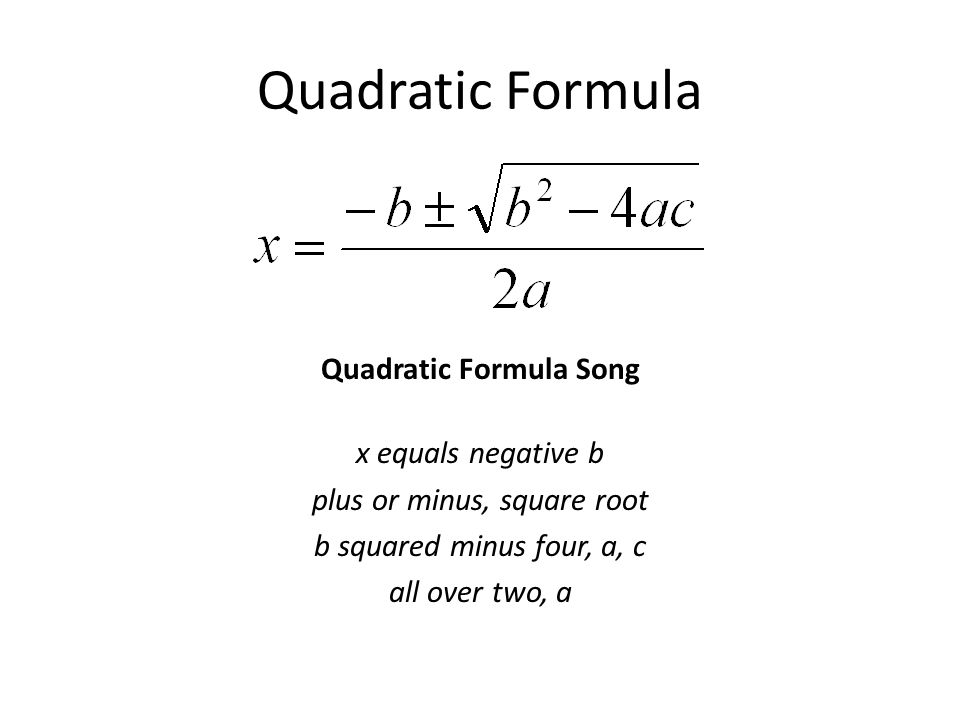
Step-by-Step Solution Using the Quadratic Formula
Solving a quadratic equation using the quadratic formula involves several steps. Follow this detailed guide to find the solutions of any quadratic equation of the form:
\[
ax^2 + bx + c = 0
\]
- Identify the coefficients:
Determine the values of \(a\), \(b\), and \(c\) from the given quadratic equation. For example, in the equation \(2x^2 + 3x - 5 = 0\), we have:
- \(a = 2\)
- \(b = 3\)
- \(c = -5\)
- Write down the quadratic formula:
The quadratic formula is:
\[
x = \frac{-b \pm \sqrt{b^2 - 4ac}}{2a}
\] - Calculate the discriminant:
Compute the value of the discriminant \(\Delta\) using the formula:
\[
\Delta = b^2 - 4ac
\]For our example:
\[
\Delta = 3^2 - 4(2)(-5) = 9 + 40 = 49
\] - Evaluate the square root of the discriminant:
Find the square root of \(\Delta\):
\[
\sqrt{\Delta} = \sqrt{49} = 7
\] - Substitute the values into the quadratic formula:
Replace \(b\), \(\sqrt{\Delta}\), and \(a\) in the quadratic formula:
\[
x = \frac{-3 \pm 7}{2(2)}
\] - Simplify the expressions:
Calculate the two possible values for \(x\):
- For the positive root:
- For the negative root:
\[
x_1 = \frac{-3 + 7}{4} = \frac{4}{4} = 1
\]
\[
x_2 = \frac{-3 - 7}{4} = \frac{-10}{4} = -2.5
\]
The solutions to the quadratic equation \(2x^2 + 3x - 5 = 0\) are \(x = 1\) and \(x = -2.5\). By following these steps, you can solve any quadratic equation using the quadratic formula, ensuring accuracy and clarity in your solutions.
Discriminant and Its Significance
The discriminant is a crucial component in the quadratic formula, playing a key role in determining the nature of the roots of a quadratic equation. For any quadratic equation of the form:
\[
ax^2 + bx + c = 0
\]
The discriminant, denoted as \(\Delta\), is given by the expression:
\[
\Delta = b^2 - 4ac
\]
Let's explore the significance of the discriminant step by step:
- Calculate the Discriminant:
Identify the coefficients \(a\), \(b\), and \(c\) from the quadratic equation. Substitute these values into the formula \(\Delta = b^2 - 4ac\). For example, for the equation \(x^2 - 4x + 4 = 0\), we have:
- \(a = 1\)
- \(b = -4\)
- \(c = 4\)
Thus, the discriminant is:
\[
\Delta = (-4)^2 - 4(1)(4) = 16 - 16 = 0
\] - Interpret the Value of the Discriminant:
The value of \(\Delta\) indicates the nature of the roots of the quadratic equation:
- If \(\Delta > 0\):
The quadratic equation has two distinct real roots. For example, if \(\Delta = 9\), then:
\[
x = \frac{-b \pm \sqrt{9}}{2a}
\]This results in two real values for \(x\).
- If \(\Delta = 0\):
The quadratic equation has exactly one real root (a repeated root). For example, if \(\Delta = 0\), then:
\[
x = \frac{-b \pm \sqrt{0}}{2a} = \frac{-b}{2a}
\]This results in one real value for \(x\).
- If \(\Delta < 0\):
The quadratic equation has two complex roots. For example, if \(\Delta = -4\), then:
\[
x = \frac{-b \pm \sqrt{-4}}{2a} = \frac{-b \pm 2i}{2a}
\]This results in two complex values for \(x\).
- If \(\Delta > 0\):
- Real-World Applications:
The discriminant is not only useful in algebra but also in various real-world scenarios, such as physics, engineering, and finance, where it helps determine the behavior of quadratic models.
By understanding and calculating the discriminant, you can gain valuable insights into the solutions of quadratic equations and their real-world implications.
Real and Complex Roots
The roots of a quadratic equation can be either real or complex, depending on the value of the discriminant (\(\Delta\)). Understanding the nature of these roots is essential for solving quadratic equations effectively. Let's explore the differences between real and complex roots step by step:
- Real Roots:
Real roots occur when the discriminant (\(\Delta\)) is greater than or equal to zero.
- Two Distinct Real Roots:
If \(\Delta > 0\), the quadratic equation has two distinct real roots. These roots can be found using the quadratic formula:
\[
x = \frac{-b \pm \sqrt{\Delta}}{2a}
\]For example, consider the equation \(x^2 - 5x + 6 = 0\). Here, \(a = 1\), \(b = -5\), and \(c = 6\). The discriminant is:
\[
\Delta = (-5)^2 - 4(1)(6) = 25 - 24 = 1
\]Since \(\Delta = 1 > 0\), the equation has two distinct real roots:
\[
x = \frac{5 \pm 1}{2} \Rightarrow x_1 = 3 \quad \text{and} \quad x_2 = 2
\] - One Real Root (Repeated Root):
If \(\Delta = 0\), the quadratic equation has exactly one real root (a repeated root). This can be found using the simplified quadratic formula:
\[
x = \frac{-b}{2a}
\]For example, consider the equation \(x^2 - 4x + 4 = 0\). Here, \(a = 1\), \(b = -4\), and \(c = 4\). The discriminant is:
\[
\Delta = (-4)^2 - 4(1)(4) = 16 - 16 = 0
\]Since \(\Delta = 0\), the equation has one real root:
\[
x = \frac{4}{2} = 2
\]
- Two Distinct Real Roots:
- Complex Roots:
Complex roots occur when the discriminant (\(\Delta\)) is less than zero. These roots involve imaginary numbers and come in conjugate pairs.
If \(\Delta < 0\), the quadratic equation has two complex roots. These roots can be found using the quadratic formula, incorporating the imaginary unit \(i\) (where \(i = \sqrt{-1}\)):
\[
x = \frac{-b \pm \sqrt{\Delta}}{2a} = \frac{-b \pm \sqrt{-|\Delta|}}{2a} = \frac{-b \pm i\sqrt{|\Delta|}}{2a}
\]For example, consider the equation \(x^2 + 4x + 5 = 0\). Here, \(a = 1\), \(b = 4\), and \(c = 5\). The discriminant is:
\[
\Delta = 4^2 - 4(1)(5) = 16 - 20 = -4
\]Since \(\Delta = -4 < 0\), the equation has two complex roots:
\[
x = \frac{-4 \pm \sqrt{-4}}{2(1)} = \frac{-4 \pm 2i}{2} = -2 \pm i
\]The solutions are \(x = -2 + i\) and \(x = -2 - i\), forming a conjugate pair.
By understanding the discriminant and its impact on the roots of a quadratic equation, you can determine whether the roots are real or complex and proceed with the appropriate solution method.
Examples and Practice Problems
Below are some examples and practice problems to help you understand the application of the quadratic formula. Remember, the quadratic formula is given by:
$$x = \frac{{-b \pm \sqrt{{b^2 - 4ac}}}}{2a}$$
Let's solve some quadratic equations step-by-step using this formula.
Example 1: Solving \( x^2 + 5x + 6 = 0 \)
Step-by-Step Solution:
- Identify coefficients: \( a = 1 \), \( b = 5 \), \( c = 6 \).
- Calculate the discriminant: $$\Delta = b^2 - 4ac = 5^2 - 4 \cdot 1 \cdot 6 = 25 - 24 = 1$$
- Since the discriminant is positive, there are two real roots.
- Apply the quadratic formula: $$x = \frac{{-b \pm \sqrt{\Delta}}}{2a} = \frac{{-5 \pm \sqrt{1}}}{2 \cdot 1} = \frac{{-5 \pm 1}}{2}$$
- Solve for the roots: $$x_1 = \frac{{-5 + 1}}{2} = \frac{{-4}}{2} = -2$$ $$x_2 = \frac{{-5 - 1}}{2} = \frac{{-6}}{2} = -3$$
- Therefore, the solutions are \( x = -2 \) and \( x = -3 \).
Example 2: Solving \( 2x^2 - 4x + 2 = 0 \)
Step-by-Step Solution:
- Identify coefficients: \( a = 2 \), \( b = -4 \), \( c = 2 \).
- Calculate the discriminant: $$\Delta = b^2 - 4ac = (-4)^2 - 4 \cdot 2 \cdot 2 = 16 - 16 = 0$$
- Since the discriminant is zero, there is one real root.
- Apply the quadratic formula: $$x = \frac{{-b \pm \sqrt{\Delta}}}{2a} = \frac{{-(-4) \pm \sqrt{0}}}{2 \cdot 2} = \frac{4 \pm 0}{4}$$
- Solve for the root: $$x = \frac{4}{4} = 1$$
- Therefore, the solution is \( x = 1 \).
Practice Problems
Try solving the following quadratic equations using the quadratic formula:
- 1. \( x^2 - 3x + 2 = 0 \)
- 2. \( x^2 - 4x - 5 = 0 \)
- 3. \( 3x^2 + 6x + 2 = 0 \)
- 4. \( 4x^2 - 12x + 9 = 0 \)
- 5. \( 5x^2 + 2x - 3 = 0 \)
Check your solutions by substituting the roots back into the original equations to verify their correctness.
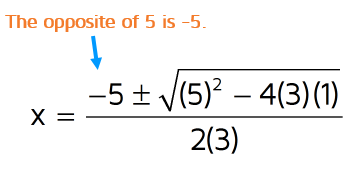
Common Mistakes to Avoid
When using the quadratic formula, it's crucial to watch out for common mistakes that can lead to errors in your calculations. Here are some pitfalls to avoid:
Incorrectly applying the signs in the formula: The quadratic formula is \(x = \frac{{-b \pm \sqrt{{b^2 - 4ac}}}}{{2a}}\). One common mistake is misplacing the signs, especially when dealing with the expression \( -b \pm \sqrt{{b^2 - 4ac}}\). Make sure to carefully determine whether to add or subtract the square root based on the signs in the formula.
Forgetting to divide by 2a: After evaluating the expression \( -b \pm \sqrt{{b^2 - 4ac}}\), it's essential to divide the result by \(2a\) to find the roots correctly. Omitting this step can lead to incorrect solutions.
Miscalculating the discriminant: The discriminant, \(b^2 - 4ac\), determines the nature of the roots (real, equal, or complex) of the quadratic equation. Failing to calculate it accurately can result in incorrect conclusions about the nature of the roots.
Using the wrong coefficients: Ensure that you substitute the correct values of \(a\), \(b\), and \(c\) from the quadratic equation into the formula. Using incorrect coefficients will yield erroneous solutions.
Ignoring the square root when simplifying: It's essential to simplify the expression \( -b \pm \sqrt{{b^2 - 4ac}}\) correctly by taking the square root of the discriminant. Neglecting this step can lead to inaccuracies in the final solutions.
Applications of the Quadratic Formula
The quadratic formula, \(x = \frac{{-b \pm \sqrt{{b^2 - 4ac}}}}{{2a}}\), is a powerful tool with numerous applications across various fields. Here are some practical uses:
Finding solutions to quadratic equations: The primary application of the quadratic formula is to find the roots of quadratic equations of the form \(ax^2 + bx + c = 0\). By substituting the coefficients \(a\), \(b\), and \(c\) into the formula, we can determine the values of \(x\) that satisfy the equation.
Modeling projectile motion: In physics, the trajectory of a projectile can often be described by a quadratic equation. By utilizing the quadratic formula, we can calculate important parameters such as the maximum height reached, the time of flight, and the range of the projectile.
Optimizing profit and cost functions: In economics and business, quadratic functions are commonly used to model profit, cost, and revenue. By applying the quadratic formula, we can determine the critical points of these functions, such as the maximum or minimum profit, which is essential for decision-making and optimization.
Engineering and design: Quadratic equations arise frequently in engineering and design problems, such as in structural analysis, electrical circuits, and optimization of mechanical systems. The quadratic formula helps engineers and designers solve complex problems and make informed decisions.
Computational algorithms: The quadratic formula is also utilized in various computational algorithms and numerical methods, including root-finding algorithms and optimization techniques. Its versatility and efficiency make it an indispensable tool in computer science and mathematics.
Graphical Interpretation
The quadratic formula, \(x = \frac{{-b \pm \sqrt{{b^2 - 4ac}}}}{{2a}}\), provides insights into the graphical representation of quadratic equations and their solutions. Here's how it can be interpreted graphically:
Vertex of the parabola: The quadratic equation \(y = ax^2 + bx + c\) represents a parabola on the Cartesian plane. The vertex of this parabola, which is the highest or lowest point depending on the direction of opening, can be found using the quadratic formula. It occurs at the \(x\) value given by \(x = \frac{{-b}}{{2a}}\).
X-intercepts: The solutions of the quadratic equation, obtained using the quadratic formula, represent the x-coordinates of the points where the graph of the parabola intersects the x-axis. These points are also known as the x-intercepts or roots of the equation.
Discriminant and nature of roots: The discriminant, \(b^2 - 4ac\), determines the nature of the roots of the quadratic equation. If the discriminant is positive, the parabola intersects the x-axis at two distinct points, indicating two real roots. If it is zero, there is one real root (a repeated root). And if it is negative, there are no real roots, indicating complex roots that lie on the imaginary axis.
Axis of symmetry: The line of symmetry of the parabola, known as the axis of symmetry, passes through the vertex and divides the parabola into two symmetrical halves. It corresponds to the vertical line with equation \(x = \frac{{-b}}{{2a}}\).
Graphical representation of solutions: Plotting the quadratic equation on a graph alongside its solutions obtained from the quadratic formula provides a visual representation of the relationship between the equation and its roots, aiding in understanding the behavior of quadratic functions.
Conclusion and Summary
In conclusion, the quadratic formula, \(x = \frac{{-b \pm \sqrt{{b^2 - 4ac}}}}{{2a}}\), is a fundamental tool for solving quadratic equations and understanding the behavior of quadratic functions. Through its applications, graphical interpretation, and derivation, we've explored the various facets of this formula. Here's a summary of key points:
The quadratic formula provides a systematic method for finding the roots of quadratic equations, which are the solutions for \(x\) that make the equation true.
Its components, including the discriminant and the coefficients \(a\), \(b\), and \(c\), play crucial roles in determining the nature and number of roots.
Applications of the quadratic formula extend across disciplines such as mathematics, physics, engineering, economics, and computer science, demonstrating its versatility and importance.
Graphical interpretation allows us to visualize quadratic equations as parabolas and understand their properties, such as vertex, x-intercepts, and axis of symmetry.
By avoiding common mistakes such as misapplying signs or forgetting to divide by \(2a\), users can ensure accurate solutions when using the quadratic formula.
Overall, the quadratic formula serves as a foundational concept in algebra and serves as a gateway to deeper understanding of quadratic equations and their applications in various fields.
Xem video này để hiểu tại sao căn bậc hai của 36 chỉ là số 6 dương và không có giá trị âm.
Tại sao sqrt(36) chỉ là 6 dương?
READ MORE:
Xem video này để học vui vẻ và nhớ lâu về công thức bậc hai thông qua một bài hát vui nhộn.
Bài hát Công thức Bậc Hai



